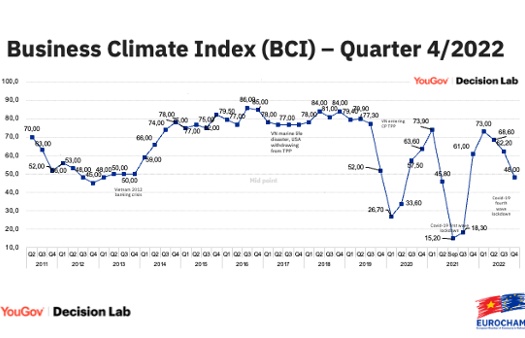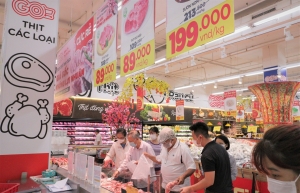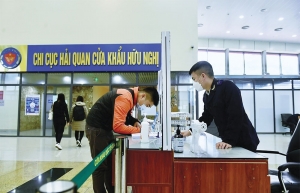Trade and investment scenarios for Vietnam
 |
| Vaibhav Saxena - Lawyer, Vilaf |
Vietnam’s export turnover is still mostly contributed by foreign-invested enterprises (FIEs), making up almost three-quarters of the country’s total. Therefore, favourable policies can promote the growth momentum in 2023 and beyond amid stiffening competition.
The government’s Decision No.1445/QD-TTg dated November last year lays down an action plan to implement the Commodity Import-Export Strategy (CEIS) to 2030.
The CEIS provides for three main objectives. Firstly, it embarks on sustainable import and export on the basis of harmonious cooperation among the commodity, market formation and trade balance with particularly complex market and market area.
Secondly, it expands commodity import and export in alliance with its investment in technical development, tech infrastructure, digital transformation, and development of green, clean, and sustainable production, along with improving the quality of human resources.
Among some others, specific targets under the CEIS are as follows:
- The average growth rate of goods exports is 6-7 per cent/year in the 2021-2030 period, in which the annual average export growth rate is 8-9 per cent for 2021-2025; 5-6 per cent for 2026-2030;
- The average growth rate of goods imports is 5-6 per cent/year for 2021-2030, of which the average import growth rate is 7-8 per cent/year for 2021-2025 and 4-5 per cent for 2026-2030;
- Maintain the trade balance in 2021-2025; strive to maintain a sustainable trade surplus in 2026-2030; look forward to a healthy and reasonable trade balance involving key trade partners;
- Increase the proportion of goods in the export processing and manufacturing industry to 88 per cent of the country’s total export turnover by 2025 and 90 per cent by 2030; including, the export proportion of medium- and high-tech goods which is expected to reach about 65 per cent by 2025 and 70 per cent by 2030;
- Increase the proportion of exports into the EU market to 16-17 per cent of the total export turnover by 2025 and 18-19 per cent by 2030; into the American market to 32-33 per cent of the total export turnover by 2025 and 33-34 per cent by 2030; and drop the proportion into the Asian market to about 49-50 per cent by 2025 and 46-47 per cent by 2030; and
- Increase the proportion of imports from the EU to 8-9 per cent of total import turnover by 2025 and 10-11 per cent by 2030; from the American market to 8-9 per cent of the total import turnover by 2025 and 10-11 per cent by 2030; decrease the proportion of imports from the Asian market to about 78 per cent of the total import turnover by 2025 and 75 per cent by 2030.
A country’s import and export activity can influence its GDP, its exchange rate, and its level of inflation and interest rates. Higher inflation can also impact exports by having a direct impact on input costs such as materials and labour. A rising level of imports and a growing trade deficit can have a negative effect on a country’s exchange rate. A weaker domestic currency stimulates exports and makes imports more expensive; conversely, a strong domestic currency hampers exports and makes imports cheaper.
The CEIS shall in turn support investment planning. The world has realised the importance of a diversified global supply chain. It provides benefits to Vietnam to invite more foreign investment into manufacturing, eventually preparing the country to have greater participation in the global value chain. Several investors are shifting their industries to Vietnam, which can even provide certain benefits such as zero VAT for export processing enterprises and preferential corporate incentives.
Domestic manufacturing shall not only support to achieve the goals set under the CEIS, but shall also enrich the investment potential, for which the current scenario and future strategy can be explained, leading to creating jobs and support the ‘Make in Vietnam’ strategy.
According to the Ministry of Planning and Investment, in 2022, the total newly registered capital, adjusted, and contributed capital to buy shares and buy contributed capital of foreign investors reached more than $27.72 billion, equivalent to 89 per cent over the same period in 2021, and up by 0.4 percentage point over the first 10 months and by 10.3 percentage point over the first nine months.
The capital disbursed by foreign-led projects was estimated at $22.4 billion during the year, an increase of 13.5 per cent on-year.
Meanwhile, Decision No.667/QD-TTg was issued in June 2022 approving the nation’s strategies on foreign investment cooperation for this decade. The nation’s specific objectives include raising the ratio of registered investment capital from countries and territories of some specified regions to more than 70 per cent by 2025 and 75 per cent by 2030.
As of December 20, 2022, exports (including crude oil) of FIEs was estimated at $276.5 billion, an increase of 12 per cent on-year, accounting for 74.4 per cent of the country’s total export turnover. If crude oil exports are excluded, the figure was $274.1 billion, up 11.8 per cent on-year, responsible for 73.8 per cent of the nation’s total.
Meanwhile, FIEs’ imports reached more than $234.7 billion, up 7.4 per cent on-year and holding 65.1 per cent of the economy’s total import turnover.
In 2022, FIEs saw a trade surplus of $41.8 billion including crude oil exports, and $39.5 billion excluding them; while Vietnamese businesses also enjoyed a trade surplus of over $30.8 billion.
Foreign investors poured funds into 19 out of 21 sectors in the national economic classification system, of which the processing and manufacturing industry took the lead with over $16.8 billion, accounting for 60.6 per cent of the country’s total overseas investment. Real estate came next with $4.45 billion, holding 16.1 per cent of the total. This was followed by electricity production and distribution (over $2.26 billion), and sci-tech activities (nearly $1.29 billion).
It is also worth noting that wholesale and retail, processing and manufacturing, and sci-tech activities were the sectors with the largest number of newly-registered projects, accounting for 30, 25.1, and 16.3 per cent of the total, respectively.
Further, in November, Resolution No.29-NQ/TW on acceleration of national industrialisation and modernisation to 2030 with a vision to 2045 was issued. As part of this, industrialisation and modernisation are viewed as a foundational and comprehensive transformation of the economy and social life based mainly on the development of industry and services based on science, technology, innovation, and creativity.
It aims to exploit and bring into full play all the potentials and advantages of the country, each region, and locality as well as the advantages of the economy during and post-golden population. It will identify areas of focus, and key fields and industries for priority in the roadmap. Finally, it highlights the task to ensure macroeconomic stability; actively integrate into the international economy; to nourish development aspirations, national entrepreneurship, and innovation; and to promote both traditional and modern cultural values.
To further boost business, one way could be through diversification of sourcing partners with a broader trade web and economical imports of intermediate goods, which should result in boosting competitiveness. Another method could be working with foreign companies to support knowledge and tech transfer to escalate value addition with the production stream.
Easing travel restrictions by providing longer duration e-visa and normal visas for business and leisure travellers to support the overall economy is also required. Vietnam should consider regulations to support trade, including those dealing with the customs.
Vietnam is under a policy transition and global security fluctuations are creating implications on several other countries. It is evident that the leadership is giving continued considerations over key pillars of the country such as the power and energy sector, banking arena, healthcare, and commodity trading.
 | European business community confident in Vietnam With Vietnam's strong economic fundamentals, and its commitment to sustainability, the European business community remains strongly confident in the Vietnamese market. |
 | Vietnam bustles with foreign tourists during Lunar New Year Many businesses are making efforts to promote traditional Lunar New Year experiences to foreign tourists. |
 | Retail sector exceeds pre-pandemic performance A recent survey of retail businesses by Vietnam Report revealed that about 54 per cent of all retail enterprises reported business performance equalling to or exceeding pre-pandemic results. |
 | The return of China: mostly positive news for Vietnam After three years of isolation, China is finally exiting its restrictive pandemic strategy. Patrick Lenain, senior associate of the Council on Economic Policies, points out how Vietnam might take advantage from this change. |
What the stars mean:
★ Poor ★ ★ Promising ★★★ Good ★★★★ Very good ★★★★★ Exceptional
Related Contents
Latest News
More News
- Climate Finance Accelerator Vietnam begins search for projects seeking investment (December 18, 2025 | 17:22)
- Vietnam and Switzerland conclude SwissTrade (December 17, 2025 | 18:22)
- TECHFEST Vietnam 2025 links startups with policy and capital (December 15, 2025 | 18:21)
- MST to allocate $3.8 billion for sci-tech in 2026 (December 15, 2025 | 18:10)
- Long Thanh International Airport welcomes first Vietnam Airlines test flight (December 15, 2025 | 18:01)
- Health Innovation Hub: accelerating health equity through digital healthcare innovation (December 15, 2025 | 08:00)
- Vietnam’s first AI Law to take effect from March 2026 (December 12, 2025 | 09:00)
- Chi Communications joins SEA CAN alliance (December 11, 2025 | 17:39)
- New Law on High Technology sets incentives and safeguards (December 11, 2025 | 09:00)
- IBTE 2025 to return to Ho Chi Minh City this December (December 11, 2025 | 09:00)

 Tag:
Tag:




















 Mobile Version
Mobile Version